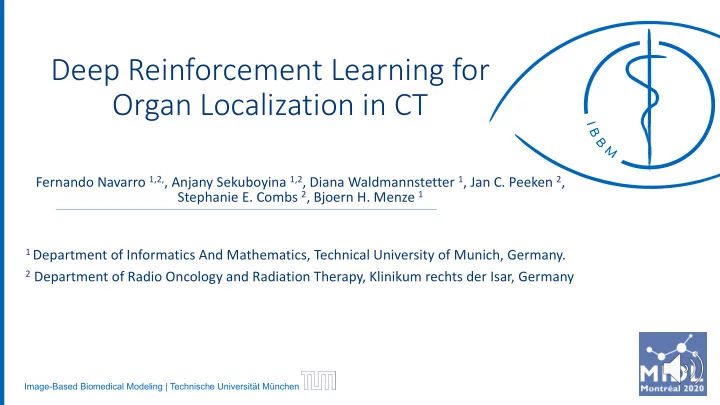

Deep Reinforcement Learning for Organ Localization in CT Fernando Navarro 1,2, , Anjany Sekuboyina 1,2 , Diana Waldmannstetter 1 , Jan C. Peeken 2 , Stephanie E. Combs 2 , Bjoern H. Menze 1 1 Department of Informatics And Mathematics, Technical University of Munich, Germany. 2 Department of Radio Oncology and Radiation Therapy, Klinikum rechts der Isar, Germany Image-Based Biomedical Modeling | Technische Universität München
Motivation Radiation Therapy Planning Registration Segmentation Analysis 2
Contributions • We show for the first time that deep reinforcement learning (RL) can be effective for the task or organ localization. • The introduction of a new set of 11 actions, which are tailored for organ localization in RL to account for the variability of organs’ sizes and shapes. • We show that for the task of organ localization, RL can learn under a limited data regimen compared to CNNs. 3
Method Random Initialized 3D box in CT scan Follows the optimal learned policy The organ localization follows a sequential process selecting optimal actions in every time step Environment : 3D CT scan 4
The Action Space 5
Translation • Translation actions do not change the neither the size nor the aspect ratio of the box. 6
Global Scaling • These actions change the size of the box but preserve the aspect ratio. 7
Aspect Ratio Actions Thinner Flatter Taller • The actions deform on one of the faces of the bounding box. • These actions are responsible for changes in the aspect ratio of the box 8
Reward Function Current box Next box Next box -1 reward +1 reward Target location Target location Target location 9
Finding the Optimal Policy • Loss function to optimize: [1] Mnih, et. Al . Human-level control through deep reinforcement learning. Nature, 2015. 10 [2] Amir Alansary, et al. Evaluating reinforcement learning agents for anatomical landmark detection. Medical image analysis, 2019.
Experiments and Results Dataset: Visceral3 [1] 11 [1] Oscar Jimenez-del Toro, et al. Cloud-based evaluation of anatomical structure segmentation and landmark detection algorithms: Visceral anatomy benchmarks, TMI.
Comparison to SOTA 12
Visualizing the training 13
Learn more about our research! Check our MIDL papers: Deep learning-based parameter mapping for joint relaxation and diffusion tensor MR Fingerprinting https://openreview.net/forum?id=wthvY6Y9e Red-GAN: Attacking class imbalance via conditioned generation. Yet another medical imaging perspective https://openreview.net/forum?id=UHtZuvXHoA Research in our group: http://campar.in.tum.de/Chair/ResearchIBBM 14
Recommend
More recommend